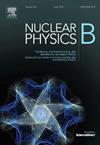四维连续自旋超粒子,N=1弯曲超空间
IF 2.8
3区 物理与天体物理
Q2 PHYSICS, PARTICLES & FIELDS
引用次数: 0
摘要
本文提出了一种描述AdS4超空间中N=1的4D连续自旋粒子动力学的新粒子模型,该模型是在256.19709 [hep-th]中提出的平面4D N=1超空间中的连续自旋超粒子模型的推广。该模型由4D, N=1超空间坐标和交换自旋附加变量描述,这些变量是连续自旋模型的固有成分。导出了拉格朗日和四个玻色子和四个费米子相空间约束系统。约束的一致性条件限制了超几何成为AdS超几何。证明了玻色子约束是一类约束。提出了一种基于附加变量的协变方法,将四种费米子约束划分为第一类和第二类。证明了与平面情况不同,只有一个费米子约束是一级约束,而其他三个是二级约束。在平面极限中,这些二级约束中的一个变成了一级约束。本文章由计算机程序翻译,如有差异,请以英文原文为准。
Continuous spin superparticle in 4D, N=1 curved superspace
We present a new particle model that describes the dynamics of a continuous spin particle in superspace and is a generalization of the continuous-spin superparticle model in flat , superspace proposed in 2506.19709 [hep-th]. The model is described by , superspace coordinates together with commuting spinor additional variables, which are inherent ingredients of continuous spin models. The Lagrangian and the system of four bosonic and four fermionic phase space constraints are derived. The consistency condition for constraints imposes a restriction on supergeometry to be superpace. It is shown that the bosonic constraints are first-class constraints. A covariant procedure based on the use of additional variables is developed to divide the four fermionic constraints into first and second classes. It is proved that, unlike the flat case, only one fermionic constraint is a first-class constraint, while the other three are second-class constraints. In the flat limit, one of these second-class constraints becomes a first-class one.
求助全文
通过发布文献求助,成功后即可免费获取论文全文。
去求助
来源期刊

Nuclear Physics B
物理-物理:粒子与场物理
CiteScore
5.50
自引率
7.10%
发文量
302
审稿时长
1 months
期刊介绍:
Nuclear Physics B focuses on the domain of high energy physics, quantum field theory, statistical systems, and mathematical physics, and includes four main sections: high energy physics - phenomenology, high energy physics - theory, high energy physics - experiment, and quantum field theory, statistical systems, and mathematical physics. The emphasis is on original research papers (Frontiers Articles or Full Length Articles), but Review Articles are also welcome.
 求助内容:
求助内容: 应助结果提醒方式:
应助结果提醒方式:


